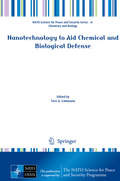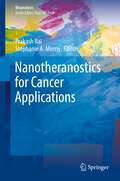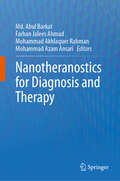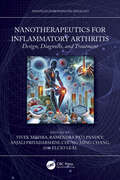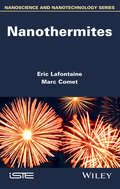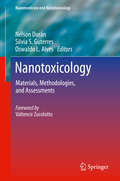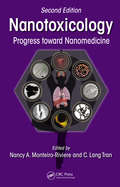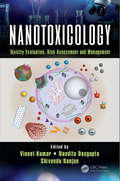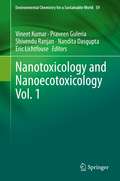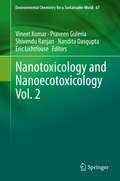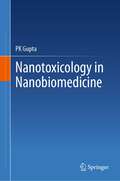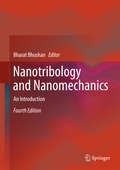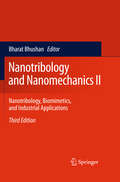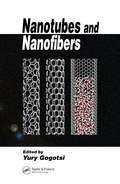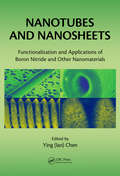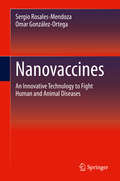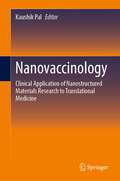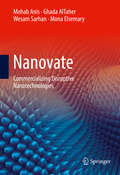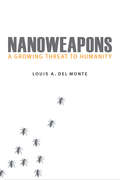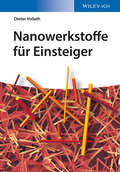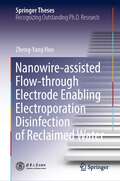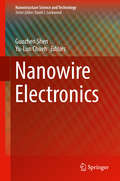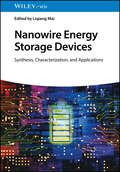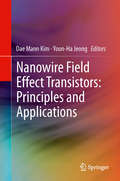- Table View
- List View
Nanotechnology Theranostics in Livestock Diseases and Management (Livestock Diseases and Management)
by Rajesh Kumar Minakshi Prasad Mayukh Ghosh Shafiq M. Syed Soumendu ChakravartiThis book reviews various applications of nanotechnology in the prophylactic, diagnostic, and therapeutic management of livestock diseases. The initial section discusses the strategies for the synthesis of nanomaterials and characterization of different nanomaterials. The subsequent chapters explore the role of nanoparticles in the diagnosis of diseases caused by pathogenic microorganisms, including bacteria, viruses, protozoans, and fungi. The book also examines the nano sensors that are used for point-of-care diagnosis of various livestock diseases. Additionally, it highlights nanoparticles-based vaccines and vaccine delivery systems to combat bacterial livestock diseases. Lastly, the book entails the strategies for developing nanotherapeutics for the treatment of bacterial, viral, fungal diseases, metabolic disorders, and cancer in livestock animals. The content of this book is useful for researchers and practitioners interested in understanding the applications of nanotechnology in diagnostics and therapeutics of livestock diseases.
Nanotechnology to Aid Chemical and Biological Defense
by Terri A. CamesanoThis book presents research into chemical, biological, radiological and nuclear (CBRN) defense and environmental security, exploring practical implications of the research. Contributions from a diverse group of international civilian researchers present the latest work on nanotechnology problems in this area, looking at detection, protective technologies, decontamination and threats to environmental security due to bacteriophages and nanomaterials. Highlights include the potential of Atomic Force Microscopy (AFM) to characterize the nanoscale properties of microbial pathogens, the development of bacteriophage-based therapeutics, prophylactic and diagnostic preparations and their uses in different fields, such as medicine, veterinary, agriculture, food and water safety, amongst others. Readers may also consider an inexpensive bioassay suited for assessing chemical poisoning in the environment such as the presence of pesticides, sensors to detect ultra-trace quantities of the explosive Pentaerythritol tetranitrate (PETN) using nanotubes and electrochemical sensors to simultaneously detect and reduce the explosive trinitrotoluene (TNT) to 2,4,6-triaminotoluene (TAT) in solution. This book shows how cooperative research among NATO countries and NATO partners can make a critical contribution to meeting the opportunities and challenges of nanotechnology problems relevant to chemical and biological defense needs. The papers presented here are representative of contributions made to the Advanced Research Workshop (ARW) on September 22-26, 2014 in Antalya, Turkey, to address the NATO SPS Key Priority of Defense against CBRN Agents and Environmental Security.
Nanotheranostics for Cancer Applications (Bioanalysis #5)
by Prakash Rai Stephanie A. MorrisThis book is the first to focus specifically on cancer nanotheranostics. Each of the chapters that make up this comprehensive volume is authored by a researcher, clinician, or regulatory agency member known for their expertise in this field. Theranostics, the technology to simultaneously diagnose and treat a disease, is a nascent field that is growing rapidly in this era of personalized medicine. As the need for cost-effective disease diagnosis grows, drug delivery systems that can act as multifunctional carriers for imaging contrast and therapy agents could provide unique breakthroughs in oncology. Nanotechnology has enabled the development of smart theranostic platforms that can concurrently diagnose disease, start primary treatment, monitor response and initiate secondary treatments if required. In oncology, chemotherapeutics have been routinely used. Some drugs have proven effective but all carry risks of adverse side effects. There is growing interest in using remotely triggered drug delivery systems to limit cytotoxicity in the diseased area. This book reviews the use of theranostic nanoparticles for cancer applications over the past decade. First, it briefly discusses the challenges and limitations of conventional cancer treatments, and presents an overview of the use of nanotechnology in treating cancer. These introductory chapters are followed by those exploring cancer diagnosis and a myriad of delivery methods for nanotherapeutics. The book also addresses multifunctional platforms, treatment monitoring, and regulatory considerations. As a whole, the book aims to briefly summarize the development and clinical potential of various nanotheranostics for cancer applications, and to delineate the challenges that must be overcome for successful clinical development and implementation of such cancer theranostics.
Nanotheranostics for Diagnosis and Therapy
by Farhan Jalees Ahmad Md. Abul Barkat Mohammad Azam Ansari Mohammad Akhlaquer RahmanThis book provides an updated account of recent advancements in the field of nanotechnology-based theranostics with special emphasis on their application in the diagnosis and treatment of various types of cancer and neurological diseases. The book is divided into two sections; the first section provides an introduction to the nanoscale theranostics & radiopharmaceuticals. The second section highlights the importance of nanoscale theranostics in disease diagnosis & treatment. It presents the potential of nanotechnology for developing nanomedicine and nanotheranostics for the diagnosis and treatment of a variety of illnesses. Further, the book discusses the usefulness of theranostic nanoparticles in the diagnosis of disease, identification of location, and stage, and in providing information about the therapy response. In addition, the book focuses on the clinical applications of nanomaterial radiolabeling in nuclear imaging of cancer and other illness. Towards the end, the bookexamines the toxicity, regulatory protocols, and future aspects of clinical applications of theranostics. This book is an invaluable source for academicians and industrial scientists working in multiple healthcare fields like pharmaceutical and biological sciences, life sciences, biotechnology, biomedical engineering, and nanobiotechnology.
Nanotherapeutics for Inflammatory Arthritis: Design, Diagnosis, and Treatment (Advances in Bionanotechnology)
by Vivek Mishra Anjali Priyadarshini Ramendra Pati Pandey Chung-Ming Chang Elcio LealNanotherapeutics for Inflammatory Arthritis: Design, Diagnosis, and Treatment highlights nanobiotechnology and its therapeutic applications in the field of inflammatory arthritis, the interaction of nanomaterials in the biological systems, and clinical development of nanomedicines. It also covers the discovery of personalized therapeutics, diagnostics, and nanoparticular delivery systems, the role of bioinformatics nanobiotechnology in personalized oncology. The use of nanosensors for the detection and current challenges in the development of personalized medicine is explained including recent nanotechnology-based strategies.Features: Covers all the fundamental information about nanotechnology and inflammatory arthritis. Highlights the interaction of nanomaterials in the biological systems, and the clinical development of nanomedicines for inflammatory arthritis. Explores the discovery of personalized therapeutics, diagnostics, and nanoparticle delivery systems. Reviews the current challenges in the development of personalized medicine as well as translation of nanomedicine with combination therapy. Discusses the toxicology of using nanomedicines and the risks associated with the use of these nanomedicines. This book is aimed at researchers and professionals in nanotechnology, biomaterial, drug delivery, and inflammatory arthritis.
Nanothermites
by Marc Comet Eric LafontaineThe recent introduction of the "nano" dimension to pyrotechnics has made it possible to develop a new family of highly reactive substances: nanothermites. These have a chemical composition that is comparable to that of thermites at submillimeter or micrometric granulometry, but with a morphology having a much increased degree of homogeneity. This book discusses the methods of preparation of these energetic nanomaterials, their specific properties, and the different safety aspects inherent in their manipulation.
Nanotoxicology
by Nelson Durán Silvia S. Guterres Oswaldo L. AlvesThis book takes a systematic approach to nanotoxicology and the developing risk factors associated with nanosized particles during manufacture and use of nanotechnology. Beginning with a detailed introduction to engineered nanostructures, the first part of the book presents concepts and definitions of nanomaterials from quantum dots to graphene to fullerenes, with detailed discussion of functionalization, stability, and medical and biological applications. The second part critically examines methodologies used to assess cytotoxicity and genotoxicity. Coverage includes interactions with blood (erythrocytes), combinatorial and microarray techniques, cellular mechanisms, and ecotoxicology assessments. Part three describes cases studies both in vitro and in vivo for specific nanomaterials including solid lipid nanoparticles and nanostructured lipid carriers and metallic nanoparticles and metallic oxides. New information is also presented on toxicological aspects of poloxamers and polymeric nanoparticles as drug carriers as well as size effects on cytotoxicity and genotoxicity. Didactic aspects are emphasized in all chapters, making the book suitable for a broad audience ranging from advanced undergraduate and graduate students to researchers in academia and industry. In all, Nanotoxicology: Materials, Methodologies, and Assessments will provide comprehensive insight into biological and environmental interactions with nanostructures. Provides an introduction to nanostructures actually in use Describes cyto- and genotoxicity methodologies, and assesses their performance in comparison to common toxicity assays Discusses the relation of cytotoxicity and genotoxicity to ecotoxicity Presents a range of applications, from biogenic silver nanoparticles to poloxamers as drug-delivery systems, reflecting the expanding applications of nanotechnology
Nanotoxicology: Progress toward Nanomedicine, Second Edition
by Nancy A. Monteiro-Riviere C. Lang Tran Joop Koster Prasen PalvankarSince the first publication of this book in 2007, the field of nanoscience and nanomedicine continues to grow substantially. This second edition, Nanotoxicology: Progress toward Nanomedicine, enlists internationally recognized experts to document the continuing development and rationale for the safe design of engineered nanomaterials (ENM). This in
Nanotoxicology: Toxicity Evaluation, Risk Assessment and Management
by Vineet Kumar, Nandita Dasgupta and Shivendu RanjanAs the application of nanotechnology in the myriad disciplines of science and engineering--from agriculture, pharmaceuticals, material science, and biotechnology to sensors, electronics, and mechanical and electrical engineering--brings benefits it also can produce serious threats to human health and the environment that must be evaluated. The unique properties of nanomaterials make them different from their bulk counterparts. In addition to such unique properties, the nanometric size of nanomaterials can invite some detrimental effects on the health and well-being of living organisms and the environment. Thus, it is important to distinguish nanomaterials with such ill effects from nanomaterials with no or minimum toxicity. Nanotoxicology: Toxicity Evaluation, Risk Assessment and Management covers issues such as the basic principles of nanotoxicity, methods used for nanotoxicity evaluation, risk assessment and its management for nanomaterial toxicity with a focus on current trends, limitations, challenges, and future directions of nanotoxicity evaluation. Various experts from different countries discuss these issues in detail in this book. This will be helpful to researchers, educators, and students who are interested in research opportunities for avoiding the environmental and health hazards of nanomaterials. This book will also be useful for industrial practitioners, policy makers, and other professionals in the fields of toxicology, medicine, pharmacology, food, drugs, and other regulatory sciences.
Nanotoxicology and Nanoecotoxicology Vol. 1 (Environmental Chemistry for a Sustainable World #59)
by Vineet Kumar Praveen Guleria Shivendu Ranjan Nandita Dasgupta Eric LichtfouseThis book discusses the basics of nanotoxicity and gives a detailed account of methods used for toxicity evaluation of nanomaterials. It also gives indepth coverage of the effect of different types of nanomaterials, including organic and inorganic, on various aquatic animals, microorganisms and plants, and outlines recent challenges, regulatory frameworks and advances in nanotoxicity testing.
Nanotoxicology and Nanoecotoxicology Vol. 2 (Environmental Chemistry for a Sustainable World #67)
by Vineet Kumar Praveen Guleria Shivendu Ranjan Nandita Dasgupta Eric LichtfouseThis book reviews advances in the toxicity of nanomaterials, with a focus on nanosensors and nanotoxicity testing, biomagnification, biotransformation, nanosafety, genotoxicity, human health and remediation. This is the second volume on Nanotoxicology and Nanoecotoxicology published in the book series Environmental Chemistry for a Sustainable World.
Nanotoxicology in Nanobiomedicine
by PK GuptaThis book provides that knowledge needed to introduce individuals to the most important research and content on nanotoxicology in nanobiomedicine. Nanotechnology is helping to considerably improve, even revolutionize many technology and industry sectors: information technology, homeland security, medicine, transportation, energy, food safety, and environmental science, among many others. There is an urgent need for a general reference textbook that presents the most recent information on the toxicity and its effects in all these sectors, biomedicine in particular. It includes historical information, nanotoxicology by subject area and or disease, sources of nanomaterials, drug delivery systems and more. Scientists, researchers, and students in all fields that use nanotechnology will find this book essential reading.
Nanotribology and Nanomechanics
by Bharat BhushanThe recent emergence and proliferation of proximal probes, e. g. SPM and AFM, and computational techniques for simulating tip-surface interactions has enabled the systematic investigation of interfacial problems on ever smaller scales, as well as created means for modifying and manipulating nanostructures. In short, they have led to the appearance of the new, interdisciplinary fields of micro/nanotribology and micro/nanomechanics. This volume serves as a timely, practical introduction to the principles of nanotribology and nanomechanics and applications to magnetic storage systems and MEMS/NEMS. Assuming some familiarity with macrotribology/mechanics, the book comprises chapters by internationally recognized experts, who integrate knowledge of the field from the mechanics and materials-science perspectives. They cover key measurement techniques, their applications, and theoretical modelling of interfaces, each beginning their contributions with macro- and progressing to microconcepts. After reviewing the fundamental experimental and theoretical aspects in the first part, Nanotribology and Nanomechanics then treats applications. Three groups of readers are likely to find this text valuable: graduate students, research workers, and practicing engineers. It can serve as the basis for a comprehensive, one- or two-semester course in scanning probe microscopy; applied scanning probe techniques; or nanotribology/nanomechanics/nanotechnology, in departments such as mechanical engineering, materials science, and applied physics. With a Foreword by Physics Nobel Laureate Gerd Binnig Dr. Bharat Bhushan is an Ohio Eminent Scholar and The Howard D. Winbigler Professor in the Department of Mechanical Engineering, Graduate Research Faculty Advisor in the Department of Materials Science and Engineering, and the Director of the Nanotribology Laboratory for Information Storage & MEMS/NEMS (NLIM) at the Ohio State University, Columbus, Ohio. He is an internationally recognized expert of tribology and mechanics on the macro- to nanoscales, and is one of the most prolific authors. He is considered by some a pioneer of the tribology and mechanics of magnetic storage devices and a leading researcher in the fields of nanotribology and nanomechanics using scanning probe microscopy and applications to micro/nanotechnology. He is the recipient of various international fellowships including the Alexander von Humboldt Research Prize for Senior Scientists, Max Planck Foundation Research Award for Outstanding Foreign Scientists, and the Fulbright Senior Scholar Award.
Nanotribology and Nanomechanics I
by Bharat BhushanThe comprehensive reference and textbook serves as a timely, practical introduction to the principles of nanotribology and nanomechanics. Assuming some familiarity with macroscopic tribology, the book comprises chapters by internationally recognized experts, who integrate knowledge of the field from the mechanics and materials-science perspectives. They cover key measurement techniques, their applications, and theoretical modelling of interfaces, each beginning their contributions with macro- and progressing to microconcepts.
Nanotubes and Nanofibers
by Yury GogotsiSize, Shape, and Synthesis Key toTuning PropertiesThe discovery and rapid evolution of carbon nanotubes have led to a vastly improved understanding of nanotechnology, as well as dozens of possible applications for nanomaterials of different shapes and sizes ranging from composites to biology, medicine, energy, transportation, a
Nanotubes and Nanosheets: Functionalization and Applications of Boron Nitride and Other Nanomaterials
by Ying Ian ChenReveals Innovative Research on BN Nanotubes and NanosheetsNanotubes and Nanosheets: Functionalization and Applications of Boron Nitride and Other Nanomaterials is the first book devoted to nanotubes and nanosheets made of boron nitride (BN). It shows how the properties of BN nanotubes and nanosheets have led to many exciting applications where carb
Nanovaccines: An Innovative Technology to Fight Human and Animal Diseases
by Sergio Rosales-Mendoza Omar González-OrtegaThis book provides a compilation of the current developments in mucosal nanovaccines, which are an attractive approach to fight against infectious and non-communicable diseases. Since nanomaterials possess unique properties; many of them have a positive effect on vaccine efficacy when used as antigen carriers and have been applied in vaccinology with significant advances over the past years. This book addresses the methodologies for mucosal nanovaccines synthesis; based on the following nanomaterials: gold, PLGA, silica, and chitosan nanoparticles; as well as nanogels, carbon nanotubes, liposomes, and Virus-like particles. A description of the immunogenic properties of the mucosal nanovaccines is presented, highlighting the improvements achieved with this approach when compared to conventional formulations. Mucosal vaccines constitute the most practical immunization approach since they are easy to administer (promoting patient´s comfort and increasing compliance), allow triggering relevant immune responses at both the site of administration and distant compartments, and thus may protect the main entry portal for pathogens (oral, nasal, and genital mucosae). In this context, the potential of nanovaccines to result in new mucosal formulations in the benefit of global health is analyzed. Covers the synthesis and functionalization of nanomaterials for the development of nanovaccines;Discusses the underlying mechanisms involved in the induction of immune responses through mucosal compartments and the advantages of nanomaterials in the formulation of nanovaccines;Transmits the state of the art for the development of mucosal nanovaccines;Provides routes for the design and evaluation of mucosal nanovaccines;Presents key perspectives for the field of mucosal vaccine development.
Nanovaccinology: Clinical Application of Nanostructured Materials Research to Translational Medicine
by Kaushik PalThis book provides an overview of the cumulative work on a driving force for innovation in medicine and modern healthcare, boosting advances in therapeutics, biosensors, vaccines, and clinical systems. The work presented shows how nanoparticles have been investigated as vaccine adjuvants because they possess chemical and structural properties that improve immunogenicity as well as the use of nanotechnology in the construction of immunization systems that has developed into the field of viral nanovaccinology. The volume highlights potential areas of research, innovation, and development of finished products for future commercialization and significant research exploration through nanoparticles that prove capable of surmounting most of the barriers like toxicity issues, clearance from biological system, DNA instability, and differences in expression systems. The contributing authors review the primary literature on principles, limitations, and recent breakthroughs in nanoparticle-based antigen delivery vehicles, their use in different diseases, the major bottlenecks, and related issues. Highlighting advances in nanoparticle engineering and the understanding of nanoparticle characteristics as well as critical legacy work dome in the field of nanobiotechnology, the book is ideal for a range of researchers and students in the pure and applied sciences devoted to nanomaterials, vaccinology, and translational medicine.
Nanovate
by Mohab Anis Ghada Altaher Wesam Sarhan Mona ElsemaryThis book introduces readers from diverse backgrounds to the principles underlying nanotechnology, from devices to systems, while also describing in detail how businesses can use nanotechnology to redesign their products and processes, in order to have a clear edge over their competition. The authors include 75 case studies, describing in a highly-accessible manner, real nanotechnology innovations from 15 different industrial sectors. For each case study, the technology or business challenges faced by the company are highlighted, the type of nanotechnology adopted is defined, and the eventual economic and social impact is described. Introduces fundamentals of nanotechnology and its applications in a highly-accessible manner Includes 75 case studies of commercializing nanotechnology from 15 industrial sectors, including Automotive, Consumer Electronics, and Renewable Energy Enables nanotechnology experts to learn simple and important business concepts to facilitate the transfer of science to the market Introduces business owners to various means to resolve industrial challenges using nanotechnologies
Nanoweapons: A Growing Threat to Humanity
by Louis A. Del MonteNanoweapons just might render humanity extinct in the near future—a notion that is frightening and shocking but potentially true. In Nanoweapons Louis A. Del Monte describes the most deadly generation of military weapons the world has ever encountered. With dimensions one-thousandth the diameter of a single strand of human hair, this technology threatens to eradicate humanity as it incites world governments to compete in the deadliest arms race ever. In his insightful and prescient account of this risky and radical technology, Del Monte predicts that nanoweapons will dominate the battlefield of the future and will help determine the superpowers of the twenty-first century. He traces the emergence of nanotechnology, discusses the current development of nanoweapons—such as the “mini-nuke,” which weighs five pounds and carries the power of one hundred tons of TNT—and offers concrete recommendations, founded in historical precedent, for controlling their proliferation and avoiding human annihilation. Most critically, Nanoweapons addresses the question: Will it be possible to develop, deploy, and use nanoweapons in warfare without rendering humanity extinct?
Nanowerkstoffe für Einsteiger
by Dieter Vollath"Nanowerkstoffe fur Einsteiger" halt, was der Titel verspricht: Eine leichtverstandliche Einfuhrung zu Nanowerkstoffen fur alle, die sich mit den Grundlagen und dem Potential dieser vielseitigen Materialklasse vertraut machen mochten, ohne allzu tief in die physikalischen und chemischen Details einzusteigen. Nanowerkstoffe sind Materialien wie Metalle, Legierungen, Keramiken oder Polymere, in denen mindestens eine Langendimension kleiner als 100 Nanometer ist. In diesem Langenbereich zeigen diese Materialien ganz besondere und fein einstellbare optische, elektrische und mechanische Eigenschaften, die auf der makroskopischen Skala nicht zutage treten. Eine Vielzahl von Anwendungen an der Schnittstelle zwischen Materialwissenschaft, Chemie, Physik und Biologie ist bereits in kommerziell erhaltliche Produkte umgesetzt worden. Jedes Kapitel beginnt mit einer Einfuhrung in den Lernstoff "In diesem Kapitel" und endet mit einer Zusammenfassung "Wichtig zu wissen". In die Tiefe gehende Erklarungen sind in Boxen aufgenommen und konnen so leicht ausgelassen werden.
Nanowire-assisted Flow-through Electrode Enabling Electroporation Disinfection of Reclaimed Water (Springer Theses)
by Zheng-Yang HuoThis Ph.D. book develops nanowire-assisted electroporation disinfection technology based on the flow-through porous electrode. The author presents pioneering results on theoretical modeling, experimental realization, and selected applications, showing the novel disinfection mechanism of electroporation guarantees an exceedingly low level of energy consumption. In this regard, three classes of novel dynamic behavior are investigated: (i) The developed nanowire-assisted flow-through electroporation disinfection technology enables great microbial disinfection performance with extremely low voltage (1V), which significantly reduce the formation potential of harmful disinfection by-products during the treatment process. (ii) The nanowire-assisted flow-through electroporation disinfection technology ensures no reactivation/regrowth of inactivated bacteria and meanwhile promotes the gradual death of damaged bacteria during the storage process. (iii) The application of high-frequency AC power supply (106 Hz) ensures the high microbial disinfection efficiency while suppressing the occurrence of electrochemical reactions and extending the electrode lifetime effectively.
Nanowire Electronics (Nanostructure Science and Technology)
by Guozhen Shen Yu-Lun ChuehThis book gives a comprehensive overview of recent advances in developing nanowires for building various kinds of electronic devices. Specifically the applications of nanowires in detectors, sensors, circuits, energy storage and conversion, etc., are reviewed in detail by the experts in this field. Growth methods of different kinds of nanowires are also covered when discussing the electronic applications. Through discussing these cutting edge researches, the future directions of nanowire electronics are identified.
Nanowire Energy Storage Devices: Synthesis, Characterization and Applications
by Liqiang MaiNanowire Energy Storage Devices Comprehensive resource providing in-depth knowledge about nanowire-based energy storage technologies Nanowire Energy Storage Devices focuses on the energy storage applications of nanowires, covering the synthesis and principles of nanowire electrode materials and their characterization, and performance control. Major parts of the book are devoted to the applications of nanowire-based ion batteries, high energy batteries, supercapacitors, micro-nano energy storage devices, and flexible energy storage devices. The book also addresses global energy challenges by explaining how nanowires allow for the design and fabrication of devices that provide sustainable energy generation. With contributions from the founders of the field of nanowire technology, Nanowire Energy Storage Devices covers topics such as: Physical and chemical properties, thermodynamics, and kinetics of nanowires, and basic performance parameters of nanowire-based electrochemical energy storage devices Conventional, porous, hierarchical, heterogeneous, and hollow nanomaterials, and in-situ electron microscopic and spectroscopy characterization Electrochemistry, advantages, and issues of lithium-ion batteries, unique characteristic of nanowires for lithium-ion batteries, and nanowires as anodes in lithium-ion batteries Nanowires for other energy storage devices, including metal-air, polyvalent ion, alkaline, and sodium/lithium-sulfur batteries Elucidating the design, synthesis, and energy storage applications, Nanowire Energy Storage Devices is an essential resource for materials scientists, electrochemists, electrical engineers, and solid state physicists.
Nanowire Field Effect Transistors: Principles and Applications
by Dae Mann Kim Yoon-Ha Jeong"Nanowire Field Effect Transistor: Basic Principles and Applications" places an emphasis on the application aspects of nanowire field effect transistors (NWFET). Device physics and electronics are discussed in a compact manner, together with the p-n junction diode and MOSFET, the former as an essential element in NWFET and the latter as a general background of the FET. During this discussion, the photo-diode, solar cell, LED, LD, DRAM, flash EEPROM and sensors are highlighted to pave the way for similar applications of NWFET. Modeling is discussed in close analogy and comparison with MOSFETs. Contributors focus on processing, electrostatic discharge (ESD) and application of NWFET. This includes coverage of solar and memory cells, biological and chemical sensors, displays and atomic scale light emitting diodes. Appropriate for scientists and engineers interested in acquiring a working knowledge of NWFET as well as graduate students specializing in this subject.

